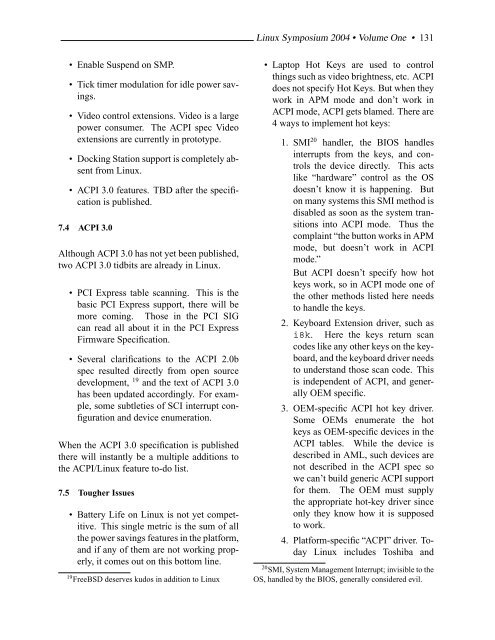Create successful ePaper yourself
Turn your PDF publications into a flip-book with our unique Google optimized e-Paper software.
<strong>Linux</strong> Symposium 2004 • Volume <strong>One</strong> • 131<br />
• Enable Suspend on SMP.<br />
• Tick timer modulation for idle power savings.<br />
• Video control extensions. Video is a large<br />
power consumer. <strong>The</strong> ACPI spec Video<br />
extensions are currently in prototype.<br />
• Docking Station support is completely absent<br />
from <strong>Linux</strong>.<br />
• ACPI 3.0 features. TBD after the specification<br />
is published.<br />
7.4 ACPI 3.0<br />
Although ACPI 3.0 has not yet been published,<br />
two ACPI 3.0 tidbits are already in <strong>Linux</strong>.<br />
• PCI Express table scanning. This is the<br />
basic PCI Express support, there will be<br />
more coming. Those in the PCI SIG<br />
can read all about it in the PCI Express<br />
Firmware Specification.<br />
• Several clarifications to the ACPI 2.0b<br />
spec resulted directly from open source<br />
development, 19 and the text of ACPI 3.0<br />
has been updated accordingly. For example,<br />
some subtleties of SCI interrupt configuration<br />
and device enumeration.<br />
When the ACPI 3.0 specification is published<br />
there will instantly be a multiple additions to<br />
the ACPI/<strong>Linux</strong> feature to-do list.<br />
7.5 Tougher Issues<br />
• Battery Life on <strong>Linux</strong> is not yet competitive.<br />
This single metric is the sum of all<br />
the power savings features in the platform,<br />
and if any of them are not working properly,<br />
it comes out on this bottom line.<br />
19 FreeBSD deserves kudos in addition to <strong>Linux</strong><br />
• Laptop Hot Keys are used to control<br />
things such as video brightness, etc. ACPI<br />
does not specify Hot Keys. But when they<br />
work in APM mode and don’t work in<br />
ACPI mode, ACPI gets blamed. <strong>The</strong>re are<br />
4 ways to implement hot keys:<br />
1. SMI 20 handler, the BIOS handles<br />
interrupts from the keys, and controls<br />
the device directly. This acts<br />
like “hardware” control as the OS<br />
doesn’t know it is happening. But<br />
on many systems this SMI method is<br />
disabled as soon as the system transitions<br />
into ACPI mode. Thus the<br />
complaint “the button works in APM<br />
mode, but doesn’t work in ACPI<br />
mode.”<br />
But ACPI doesn’t specify how hot<br />
keys work, so in ACPI mode one of<br />
the other methods listed here needs<br />
to handle the keys.<br />
2. Keyboard Extension driver, such as<br />
i8k. Here the keys return scan<br />
codes like any other keys on the keyboard,<br />
and the keyboard driver needs<br />
to understand those scan code. This<br />
is independent of ACPI, and generally<br />
OEM specific.<br />
3. OEM-specific ACPI hot key driver.<br />
Some OEMs enumerate the hot<br />
keys as OEM-specific devices in the<br />
ACPI tables. While the device is<br />
described in AML, such devices are<br />
not described in the ACPI spec so<br />
we can’t build generic ACPI support<br />
for them. <strong>The</strong> OEM must supply<br />
the appropriate hot-key driver since<br />
only they know how it is supposed<br />
to work.<br />
4. Platform-specific “ACPI” driver. Today<br />
<strong>Linux</strong> includes Toshiba and<br />
20 SMI, System Management Interrupt; invisible to the<br />
OS, handled by the BIOS, generally considered evil.

















